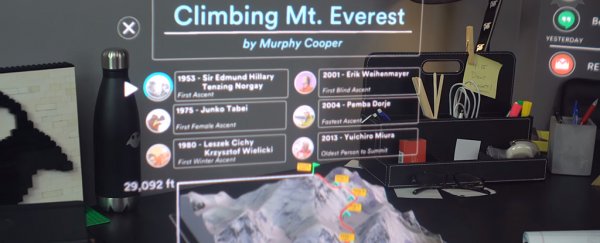
If you've never heard of Magic Leap before, we'll forgive you: the company has made something of a name for itself by not making a name for itself… if that makes sense. What we do know is that it's working on some kind of next-generation augmented reality, and you can watch the brand new demo video showing it off above.
Emails, tasks, and charts float magically in the air, messaging apps hover above a desk, and a 3D holographic representation of Mount Everest rises out of nowhere. Undoubtedly, this is some impressive technology, and few outside of Magic Leap know how it works. Like, at all.
Despite the promise of its title, Wired's "The Untold Story of Magic Leap" article doesn't reveal too much about the company's inner workings. The business has attracted hundreds of millions of dollars in investment from the likes of Google and other big Silicon Valley names though, so it must be doing something right.
What we do know is that Magic Leap is building something called Mixed Reality (MR) – it's like virtual reality (VR), but these virtual objects appear within our real world. It's slightly different to augmented reality (AR), but even those in the industry tend to disagree about the semantics of these terms, which makes it confusing for consumers.
Perhaps the best approach is to consider the hardware. The HTC Vive and Oculus Rift offer VR, full-on immersive digital experiences. Google Glass, meanwhile, is in the AR camp: digital projections with the real world still visible behind them. Magic Leap falls somewhere in the middle.
MR takes AR and makes it more realistic - a kind of AR with a dash of VR mixed in, as Re/code explains. Whatever hardware is powering the "magic goggles", as Wired's Kevin Kelly called them, is still a mystery. So far, one of the only other MR devices around is Microsoft's HoloLens.

From the snippets of information released by Magic Leap, we know that its 'goggles' claim to offer a mixed reality experience more immersive than ever, with advanced systems for controlling depth perception and drawing graphics in front of the eyes. Putting the glasses on "felt natural," reports Kelly, "as comfortable as slipping off sunglasses".
The images themselves are projected sideways onto a semi-transparent material that sits in front of the eye, then reflected straight into the retina. Apparently, Magic Leap's beaming and rendering technology is unique, though it's not saying why yet.
Ultimately, pixels disappear: the jumping whale or miniature elephant is, as far as your eyes are concerned, actually in the room. It's still going to be some years before Magic Leap is a household name, but this is likely to be The Next Big Thing in tech.
The "futuristic synthetic reality" offered by Magic Leap is better than watching: it's actually experiencing. Rather than reading about volcanoes, you'll be able to stand in one; instead of learning about ancient Rome, you'll be able to take a tour around it by conjuring it inside your living room. Or, on a more practical level, you could project a TV screen on your wall instead of buying a bulky real one.
"Mixed reality doesn't take you out of this world," director Peter Jackson of Lord of the Rings fame told Wired. "Instead, it adds elements to our real world. If you have your Magic Leap glasses on, you can look up at the Empire State Building and watch it being built in the early 1930s, floor by floor, but sped up. Maybe while you are walking around the modern streets of Chicago you see gangsters driving past with tommy guns."
"It could be a form of education, entertainment, and tourism. In 10 years I expect that mixed-reality technology like Magic Leap will be used as much as, if not more than, smartphones."
